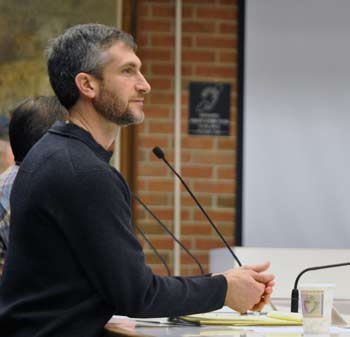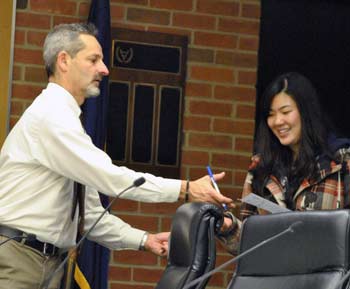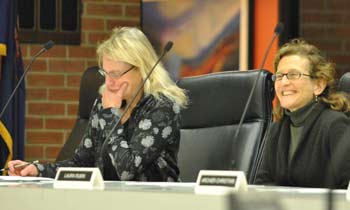Greenbelt Commission Wraps Up 2012
Ann Arbor greenbelt advisory commission meeting (Dec. 6, 2012): Commissioners ended the year with a relatively brief meeting, which included a vote to smooth the way for land preservation in 2013.

Christopher Taylor, a Ward 3 Ann Arbor city councilmember, was recently appointed to the city’s greenbelt advisory commission and attended his first meeting on Dec. 6. (Photos by the writer.)
GAC members authorized staff to proceed with property appraisals, as needed, to prepare for possible grant applications to the U.S. Department of Agriculture’s Farm and Ranchland Protection Program (FRPP). There’s some uncertainty about how much grant funding will be available, but Ginny Trocchio – who provides staff support for the greenbelt program – anticipates the deadline to apply will be in early March. She is seeking landowners who might be willing to sell their property’s development rights in deals that would be eligible for FRPP grants.
Trocchio also noted that the city hopes to close on five pending deals by the end of 2012. If that happens, it would bring the total amount of land protected through the greenbelt to about 4,200 acres. The program is funded by a 30-year millage approved by Ann Arbor voters in 2003, and organizers at that time hoped to preserve between 3,500 to 4,500 over the life of the millage. Land prices have fallen since that time because of the economic downturn, allowing the program to protect more land than originally anticipated. The land is protected primarily through the purchase of development rights.
The Dec. 6 meeting also included some housekeeping tasks: the election of officers, and approval of GAC’s 2013 calendar. Current officers were re-elected – Dan Ezekiel as chair, and Catherine Riseng as vice chair. Ezekiel noted that his term ends in mid-2013 and he’ll be term-limited at that point, so a new chair will be needed then. Laura Rubin will also be cycling off GAC next summer . She and Ezekiel are the last of the original commissioners who were appointed in 2004, when the greenbelt program was formed.
The meeting was the first for Ann Arbor city councilmember Christopher Taylor (Ward 3), who was appointed to GAC at the council’s Dec. 3 meeting. Taylor also serves as one of the council representatives on the city’s park advisory commission. Ezekiel noted that it will be good to have a “direct pipeline” between the two groups. At least a couple of greenbelt commissioners also commented to Taylor that they were glad to have a city councilmember again on GAC. The previous city council appointee, Carsten Hohnke, attended only one GAC meeting in 2012. Hohnke did not run for re-election to the council and ended his council service in early November.
Election of Officers
GAC chair Dan Ezekiel noted that the commission needed to do some “cleaning up” that was overlooked in July – the election of officers. He suggested electing officers for a six-month term, in order to get back on track with July elections next year.
Laura Rubin asked whether Ezekiel and Catherine Riseng, the current vice chair, were willing to continue serving. They indicated that they were. In that case, Rubin said she’d nominate them, unless others were interested. No one responded to that gambit.
Outcome: Commissioners unanimously re-elected Dan Ezekiel as chair and Catherine Riseng as vice chair.
After the vote, Ezekiel noted that his current term ends on June 30, 2013 and he can’t be reappointed to GAC because of term limits. So there will be at least one new officer elected at that time, he said.
The terms of two other current members – Tom Bloomer and Laura Rubin – also end on June 30, 2013. Like Ezekiel, Rubin has served since the commission was formed in 2004 and will be term limited. Bloomer was first appointed in 2007 and reappointed in 2010 – he’s also term-limited.
GAC’s original members served initial staggered terms, plus two additional three-year terms. Current GAC member are limited to serving two three-year terms. Some terms of current commissioners were restated in 2011 by council resolution, for various administrative reasons.
Here’s a list of current GAC members, the category they represent (as stipulated by city ordinance) and their terms:
- Dan Ezekiel (public at large): first appointed in 2004, current term ends June 30, 2013. Status: term limited.
- Laura Rubin (environmental organization): first appointed in 2004, current term ends June 30, 2013. Status: term limited.
- Tom Bloomer (farmer): first appointed in 2007, current term ends June 30, 2013. Status: term limited.
- Liz Rother (public at large): first appointed in 2011, current term ends June 30, 2014. Status: eligible for reappointment.
- Shannon Brines (public at large): first appointed in 2011, current term ends Nov. 20, 2014. Status: eligible for reappointment.
- Peter Allen (real estate developer): first appointed in 2008, current term ends June 30, 2015. Status: term limited.
- Catherine Riseng (biologist): first appointed in 2010, current term ends June 30, 2015. Status: term limited.
- Archer Christian (environmental organization): first appointed in 2012, current term ends July 1, 2015. Status: eligible for reappointment.
- Christopher Taylor (city council representative): first appointed in December 2012 through 2013.
[.pdf of Chapter 42 of the Ann Arbor city code: Open space and parkland preservation]
Land Deals
Ginny Trocchio, who provides staff support for the greenbelt program, reported that she anticipated the next round of funding available from the U.S. Department of Agriculture’s Farm and Ranchland Protection Program (FRPP) would be announced soon. Congress has not yet authorized a new farm bill, she noted, but did pass a continuing resolution that included FRPP funding. It’s not yet clear how much will be appropriated for Michigan projects, however.

Dan Ezekiel, chair of the greenbelt advisory commission, gives his signature to students who attended the Dec. 6 meeting for a class assignment, and who needed proof of their attendance.
Based on the schedules from previous years, it’s likely that FRPP applications will be due in early March of 2013, Trocchio said. That’s a short timeframe, she added, so it’s important to try to line up landowners now who might be willing to apply.
GAC’s next meeting is scheduled for Jan. 3, but it might be cancelled if not enough members can attend to achieve a quorum. So Dan Ezekiel suggested that the commission authorize staff to order any appraisals that might be necessary between now and GAC’s next meeting, for properties that might seek FRPP grants. He said that GAC had taken this kind of action previously, so there’s precedent for it.
Laura Rubin asked whether Trocchio had actually gotten appraisals in this way in previous years. Trocchio couldn’t remember, but noted that any FRPP applications would be brought to GAC and the city council before they are submitted to the federal program.
Outcome: Commissioners voted unanimously to authorize staff to order appraisals as needed until GAC’s next meeting.
Staff & Commissioner Updates
In her staff update, Ginny Trocchio reported that she hoped the city would close on five more greenbelt deals by the end of 2012, protecting an additional 450 acres. If that happens, it would bring the total amount of protected acres to about 4,200 since the greenbelt program launched, she said. The majority of that acreage is agricultural land protected through the purchase of development rights (PDR).
Trocchio noted that when the program began, the expectation was that it would fund protection for between 3,500 to 4,500 over the life of the 30-year millage. “The economy’s been good for us, at least,” she said, in terms of lowering the cost of farmland.
At a joint meeting held last month between GAC and the city’s park advisory commission, Trocchio had provided a more detailed update. She had noted then that land previously valued at about $16,000 per acre is now closer to $4,000, with the likelihood of even lower costs in the coming year. In a PDR deal, the landowner retains ownership of the land but sells development rights to the land. Those rights are protected through a conservation easement, which limits the kinds of development and activity that can occur on the land.
At the Dec. 6 GAC meeting, Trocchio also cited the partnerships with other local communities as a factor in helping protect a greater amount of land than anticipated.
Updates: Strategic Plan
Trocchio told commissioners that she had hoped to get input on proposed revisions to the greenbelt program’s strategic plan at the November meeting of Preserve Washtenaw, but that meeting had been cancelled. Preserve Washtenaw is a consortium of local land preservation groups, including the Legacy Land Conservancy, Washtenaw County’s natural areas preservation program, and several township programs.
Preserve Washtenaw members have copies of the strategic plan, Trocchio said, and she hopes to get their feedback in January. If that happens, GAC can consider that input at its meeting in February.
Commissioners had discussed proposed revisions to the strategic plan at their September 2012 meeting, but have not yet approved it. [.pdf file of 2012 draft greenbelt strategic plan]
Updates: Mayoral Proclamation
Trocchio highlighted a proclamation made by mayor John Hieftje at the Ann Arbor city council’s Oct. 15, 2012 meeting, declaring Oct. 24 as National Food Day in Ann Arbor. At the request of Dan Ezekiel, Trocchio read aloud the proclamation’s “whereas” clause that specifically related to the greenbelt program:
WHEREAS, the City’s Greenbelt program is an innovative land preservation program that has protected over 3,700 acres of farmland and open space surrounding the City of Ann Arbor, and has leveraged over $19 million through grants, landowner donations, and other locally funded programs.
Updates: Greenbelt Panel Discussion
Ezekiel reminded commissioners that a panel discussion focused on the greenbelt program had been held on Nov. 7 at the downtown Ann Arbor District Library. It had featured landowners who have participated in the program, including GAC member Tom Bloomer, who owns Bur Oaks Farm in Webster Township. The event was videotaped and will eventually be posted on the AADL website.
Contract with The Conservation Fund
Laura Rubin asked about the status of the city’s process to hire administrative support for the greenbelt program. The city had issued a request for proposals (RFP) in early November, with a Nov. 28 deadline for responses. [.pdf of management RFP] The contract is to manage operations for the city’s greenbelt and parkland acquisition programs, which are funded by a 30-year 0.5 mill open space and parkland preservation millage that voters approved in 2003.
Sumedh Bahl, the city’s community services area administrator, reported that proposals are under review and a recommendation is expected to be sent to city council in January. The contract would be for a one-year period, with the option for two one-year renewals. Bahl later clarified for The Chronicle that only one proposal had been received – from The Conservation Fund.
The Conservation Fund has held that contract since the greenbelt program launched. The current three-year contract ends on Jan. 15, 2013. The nonprofit is headquartered in the suburbs of Washington, D.C. Ginny Trocchio is the nonprofit’s Ann Arbor staff member.
The current contract was approved by the Ann Arbor city council on Dec. 21, 2009. It authorized $119,565 in 2010, with two one-year renewal options for $113,661 in 2011 and $106,797 in 2012. The Conservation Fund also was the only bidder for that request for proposals (RFP).
Dan Ezekiel thanked Catherine Riseng for serving as GAC’s point person on the RFP review committee for this contract renewal.
Present: Peter Allen (arrived late), Tom Bloomer, Shannon Brines, Archer Christian, Dan Ezekiel, Catherine Riseng, Laura Rubin, Christopher Taylor. Staff: Ginny Trocchio.
Absent: Liz Rother.
The Chronicle survives in part through regular voluntary subscriptions to support our coverage of publicly-funded entities like the city’s greenbelt program. If you’re already supporting The Chronicle, please encourage your friends, neighbors and coworkers to do the same. Click this link for details: Subscribe to The Chronicle.




